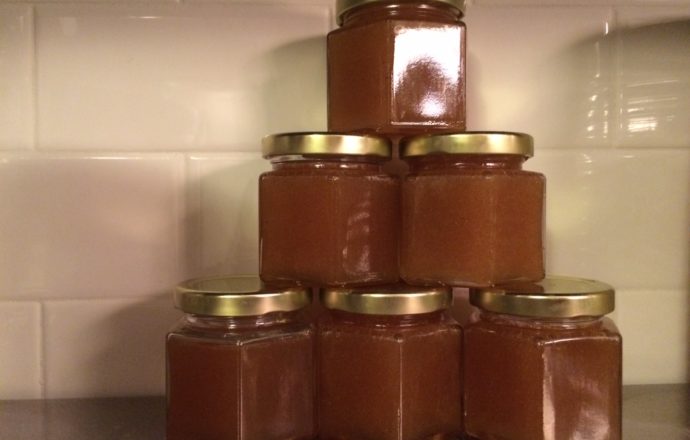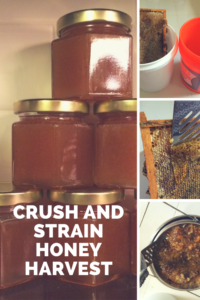I’ve been incredibly lax with my beekeeping this spring. I can blame the weather (we seriously had rain every Saturday and Sunday in April and May), but I also don’t care that much about honey. And when you don’t care about honey, bees are incredibly easy to keep. Most of beekeeping advice seems to revolve around preventing the bees from swarming. For those not aware (which is probably everyone reading this), a swarm isn’t just bees flying around together in a big cloud. A swarm is what happens when the bee colony gets too large for the space available in the hive. You have a big, healthy hive one day and the next your queen flies away with half of your bees. The hive is left with a developing queen cell and enough worker bees hanging around to tend to any remaining brood in the hive.
I get how swarming would be devastating for the honey-lovers, but to me it’s just not the end of the world. I only keep bees to pollinate my garden, so even if they swarm I’ll have one colony in the hive and another colony somewhere nearby in the wild. That has to be good!
Regardless of my laissez faire attitude towards swarming, my bees didn’t swarm this spring. In between bouts of Saturday rain I was able to throw a couple extra boxes on top of the hive just in case they needed them. Now, this is definitely not what you’re supposed to do. All the beekeeping books say that a hive with too much space may swarm too. So I guess I got lucky. And when I finally got into the hive to do an inspection, I had honey to harvest. And truly needed to harvest it soon because I was out of boxes to throw on the stack. Plus, I don’t know how high I can stack before the whole thing falls over. That does not sound like a fun day.
So last week I prepared myself for the harvest. Harvesting honey starts with “robbing the hive.” That’s exactly what it sounds like: taking the honey away from the bees. As I’m sure you’ll guess, they don’t like to abandon their honey. So you have to find the right way for you to remove the bees from the box you want to harvest. There are several methods used for this. Some beekeepers put a pad of smelly stuff in the top box that the bees don’t like. They’ll move down the hive to get away from the stink. I didn’t want to do that because I don’t want to make my bees unhappy. Not to be a giant hippie (too late), but the bees do a lot for us so it seems wrong to make them uncomfortable. Another method people use is to use a leaf blower to blow the bees away. I don’t have a leaf blower, so that wasn’t really an option. And again, it seems pretty unpleasant for the bees so I didn’t really want to do that.
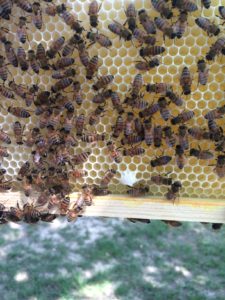
There is no good reason for me to include this picture here. There’s no honey here! Just freshly-drawn comb. But it seemed like it was time for a picture.
The method I chose to use was installation of a bee escape. A bee escape is exactly what it sounds like: a little door that allows the bees to escape the box but doesn’t let them back in. The bees will all need to leave at some point to relieve themselves or forage, so they’ll go through the one-way door. After a few days, the box is nearly empty of bees. I chose this model. It was pretty cheap and available with Prime shipping, so why not? I will say, that this bee escape did not fit my inner cover. When you’re all suited up and have thick beekeeping gloves on, that seems like an insurmountable problem. Once inside, it wasn’t a big deal to carve away some of the hole in my inner cover. And I don’t know if it’s the bee escape’s problem or if my inner cover was a weird shape. So anyway, armed with a newly-whittle inner cover and bee escape, I headed out to the hive. And couldn’t lift the honey super. A full super is about fifty pounds (which I can definitely lift). Unfortunately I cannot lift fifty pounds that is already about shoulder height. I happen to live just one mile from my parents and my dad is really helpful when things like this arise. I called him and he headed over to help out.
Now here’s where things go wrong. Dad and I were putting on our bee suits and I said “I don’t know why I’m suiting up since you’ll have to do everything.” And he agreed because seriously the entire task was lifting a box, sticking a board on top of the lower box, and then replacing the top box. Not exactly a two-man job. So Dad got to work. Since this was such a small task, we hadn’t lit the smoker. We’ll do that from time to time because it’s really a lot easier to just walk away for a minute if the bees get a little overwhelming. Plus I feel like it’s nicer for the bees (seriously, how did I become such an Earth-Mother type?). So Dad’s working the hive and he needs a break. And instead of walking to the other side of the yard, he comes to stand by me. With about 5,000 bees covering him. One of the bees flew off him and directly into my ear canal. So now I’m running around shaking my head like a crazy person and this poor bee is just trying to figure out how to get out of there. For about forty seconds. Then she managed to get out of my ear just to then get stuck in my hair. Because of course that’s how that works. So another twenty seconds or so of running around hoping she’ll fly away. And she did because my bees are the best.
After Dad finished up, it was time to wait three days before robbing the hive. My parents left town on day two, so I knew I would need a tall, strong man to help me out. Enter Khaled. Khaled is a truly fantastic person who had never worked with bees before but immediately agreed when I asked if he could help. He’s just that nice a guy. I’m supposed to be finding him a wife, so let me know if you’re interested! He’s 39 and truly one of the kindest human beings you’ll ever meet. Oh, and he has a doctorate in physical chemistry.
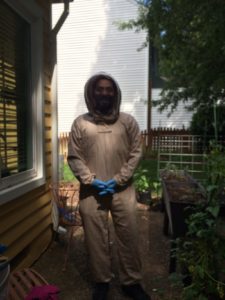 Robbing the hive was so easy. I loosened the top box with the hive tool and Khaled carried it away to the front porch while I replaced the outer cover. Once we were both on the front porch, we removed each frame individually and brushed off any remaining bees. I put a 5-gallon bucket right inside the front door so every time we cleared a frame of bees, I stuck the frame in the bucket so the bees couldn’t fly back to the frame.
Robbing the hive was so easy. I loosened the top box with the hive tool and Khaled carried it away to the front porch while I replaced the outer cover. Once we were both on the front porch, we removed each frame individually and brushed off any remaining bees. I put a 5-gallon bucket right inside the front door so every time we cleared a frame of bees, I stuck the frame in the bucket so the bees couldn’t fly back to the frame.
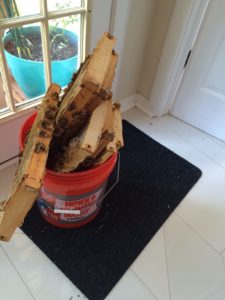 And with that, my lovely assistant was no longer needed. Having grown up in the south, it is ingrained into me to offer refreshment to anyone who comes over. (I have a feeling that that’s ingrained into anyone with a decent upbringing but we southerners like to pretend we’re the only ones with manners) But, it’s Ramadan, y’all! Muslims all over the world are fasting during daylight hours so I couldn’t even give him a glass of water. Not providing a meal for his help was one of the most difficult things I’ve experienced. Which I guess means my life is ridiculously easy, right? But seriously, this was yesterday morning and I’m still feeling like the worst hostess of all time.
And with that, my lovely assistant was no longer needed. Having grown up in the south, it is ingrained into me to offer refreshment to anyone who comes over. (I have a feeling that that’s ingrained into anyone with a decent upbringing but we southerners like to pretend we’re the only ones with manners) But, it’s Ramadan, y’all! Muslims all over the world are fasting during daylight hours so I couldn’t even give him a glass of water. Not providing a meal for his help was one of the most difficult things I’ve experienced. Which I guess means my life is ridiculously easy, right? But seriously, this was yesterday morning and I’m still feeling like the worst hostess of all time.
So now I had a bucket of honey frames just waiting to be harvested. Initially I had thought we’d rob the hive and then I could do the real harvesting whenever I felt like it, but as you can see the frames didn’t fit neatly in the bucket. They were dripping on the floor so I figured I should take care of them then. So that’s how my Sunday was spent getting increasingly sticky.
There are a few ways to harvest honey. If you want comb honey, you just cut your squares out of the frame and you’re done. That sounds delightful, but I use frames with plastic foundation so that’s not an options for me. Plus, I don’t understand the desire for comb honey. For liquid honey harvesting of large amounts of honey, you’ll want to get your hands on a honey extractor. That’s basically a big centrifuge that spins the honey out of the comb. The biggest benefit to using an extractor is that you end up keeping the honeycomb on your foundation. That way when you reuse those frames, the bees don’t need to waste time and energy rebuilding the comb.
Alas, I do not have a honey extractor. Not only are extractors expensive, but they’re big! Given how small I expected my honey harvest to be it seemed foolish to store something the size of a backyard smoker. But fear not! You don’t need a giant piece of equipment to harvest a few frames of honey. All you need is a spatula, a potato masher, and a strainer.
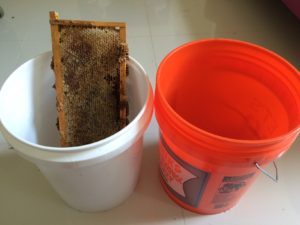 I grabbed another couple of buckets to get started. The white bucket on the left is food-safe and has never been used for anything but this honey harvest. The bucket on the right is one of my many “I don’t need no man” Home Depot buckets. I just used that bucket to hold already-extracted frames so I didn’t even bother completely cleaning it.
I grabbed another couple of buckets to get started. The white bucket on the left is food-safe and has never been used for anything but this honey harvest. The bucket on the right is one of my many “I don’t need no man” Home Depot buckets. I just used that bucket to hold already-extracted frames so I didn’t even bother completely cleaning it.
 Next I just started scraping the honey off the frames with my spatula. I wish I had chosen a prettier frame for the picture, but by the time I got to a prettier frame my hands were way too sticky to pick up my phone again. Oh, this is a good time to tell you: if you harvest honey you are going to be sticky. It’s terrible. I’ve taken so many showers because the memory of that stickiness haunts me.
Next I just started scraping the honey off the frames with my spatula. I wish I had chosen a prettier frame for the picture, but by the time I got to a prettier frame my hands were way too sticky to pick up my phone again. Oh, this is a good time to tell you: if you harvest honey you are going to be sticky. It’s terrible. I’ve taken so many showers because the memory of that stickiness haunts me.
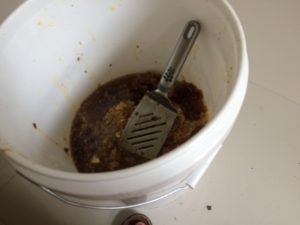 As you scrape your frames, you’ll get this ugly sludge filling your bucket. That’s a mixture of honey (of course), beeswax, and pollen. You want to crush as much of the honey comb so that the honey can be released from the cells. This is where the potato masher comes in. Just mash away! Once you’re done with that, you need to strain the mixture to separate the beeswax from the honey and pollen.
As you scrape your frames, you’ll get this ugly sludge filling your bucket. That’s a mixture of honey (of course), beeswax, and pollen. You want to crush as much of the honey comb so that the honey can be released from the cells. This is where the potato masher comes in. Just mash away! Once you’re done with that, you need to strain the mixture to separate the beeswax from the honey and pollen.
 I got all fancy and bought an actual honey strainer, but you can definitely get away with a cheesecloth-lined colander. This process took FOREVER. I kept thinking that it would never end. I was set up in the living room though so at least I could watch Elementary on Hulu while I waited. I just kept scooping in more whenever it looked like there was space again.
I got all fancy and bought an actual honey strainer, but you can definitely get away with a cheesecloth-lined colander. This process took FOREVER. I kept thinking that it would never end. I was set up in the living room though so at least I could watch Elementary on Hulu while I waited. I just kept scooping in more whenever it looked like there was space again.
I harvested six frames of honey and that yielded about 8 quarts of strained honey. Honestly, if I’d have been more patient with the straining I think I’d have gotten more. How do I know? Because so much honey drained onto the ground when I put the sticky cappings outside for the bees to clean!
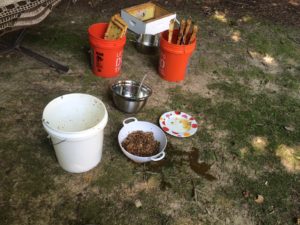 Look at that puddle of honey coming off the colander. Crazy.
Look at that puddle of honey coming off the colander. Crazy.
And here’s a closeup of the colander today. Those bees are going crazy hanging out underneath the colander.
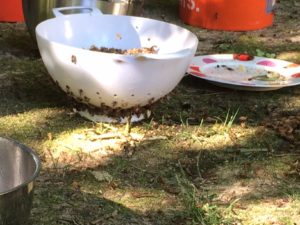 So at that point, I guess the honey was harvested. This evening when I got in from the yard I started bottling it. Given that I didn’t expect to have so much honey, I bought these small hex jars. I filled the dozen I had already purchased but that’s nowhere close to enough. My guess is I’ll need another four dozen of these jars.
So at that point, I guess the honey was harvested. This evening when I got in from the yard I started bottling it. Given that I didn’t expect to have so much honey, I bought these small hex jars. I filled the dozen I had already purchased but that’s nowhere close to enough. My guess is I’ll need another four dozen of these jars.
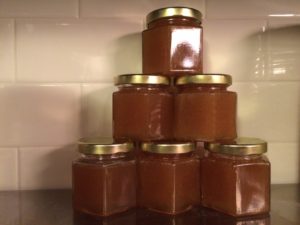 I haven’t decided on a label design yet. I’m thinking of using Yellow House Farm as a “brand” because everyone who comes over jokes that I should be a farmer. And then something like “Organic Honey from an Organic Chemist.” If I was selling this honey, I wouldn’t be able to label it organic without going through a lot of certification. But I’m giving it away as gifts so I’m pretty sure I’m safe. Plus, the requirements for honey to be organic are kind of up in the air. Many want to label their honey as organic as long as they don’t use any non-organic treatments on their hives. If that’s the requirement, then I do indeed have organic honey. Still others claim that if the hive is within five miles of any non-organic land use, then the honey isn’t organic. I definitely don’t qualify then. I think I’ve probably mentioned before that I live on 1/5 acre. I have no idea what is being sprayed on lawns in my immediate vicinity, much less anywhere within a five mile radius.
I haven’t decided on a label design yet. I’m thinking of using Yellow House Farm as a “brand” because everyone who comes over jokes that I should be a farmer. And then something like “Organic Honey from an Organic Chemist.” If I was selling this honey, I wouldn’t be able to label it organic without going through a lot of certification. But I’m giving it away as gifts so I’m pretty sure I’m safe. Plus, the requirements for honey to be organic are kind of up in the air. Many want to label their honey as organic as long as they don’t use any non-organic treatments on their hives. If that’s the requirement, then I do indeed have organic honey. Still others claim that if the hive is within five miles of any non-organic land use, then the honey isn’t organic. I definitely don’t qualify then. I think I’ve probably mentioned before that I live on 1/5 acre. I have no idea what is being sprayed on lawns in my immediate vicinity, much less anywhere within a five mile radius.
